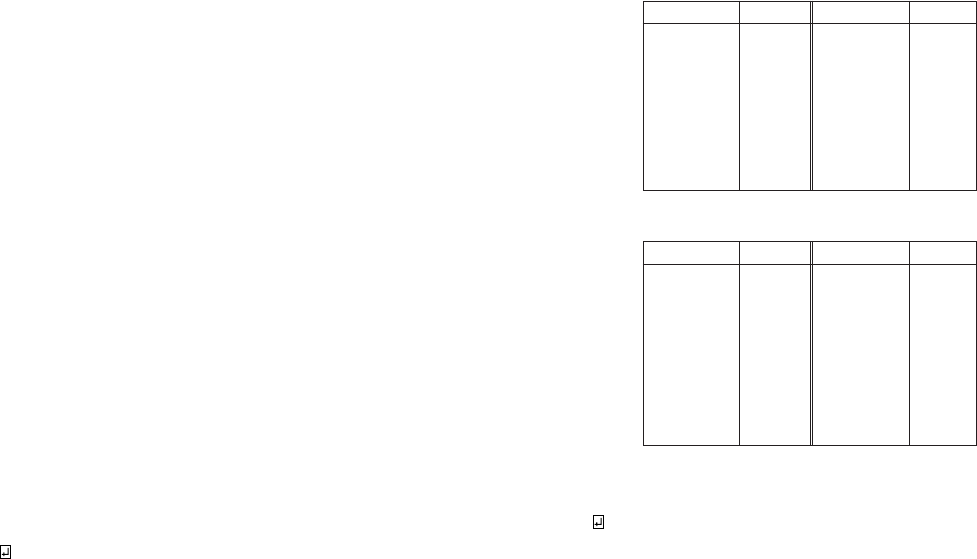
E-9
Shift indicator
This indicator appears when you press the SHIFT key. While
this indicator is on the display, the keyboard is shifted, so the
letter keys input the opposite of their current upper-case/lower-
case setting. The number keys input the punctuation symbols
marked in the upper right corners of the keys. The keyboard
automatically unshifts (and the shift indicator disappears) as
soon as you input a character.
Code indicator
This indicator appears when you press the CODE key. While
this indicator is on the display, number keys input the
accents marked above them and the U, O, P, A, S, J, K, L,
Z, C and N keys input the special characters marked in their
lower right corners. The keyboard automatically returns to
normal (and the code indicator disappears) as soon as you
input an accent.
Character size display indicator
This indicator shows the size of the character where the
cursor is currently located. The letter “F” to the right of the
character size indicates a preset format is being used.
The letter “S” indicates that the label printer’s small typeface
is selected.
Block number
This value appears when there are multiple blocks in the
text. It shows the sequential number of the block where
the cursor is currently located (page E-16).
Format
This indicator shows how many lines of text have been in-
put. See page E-25 for important information about how
various format conditions are indicated.
Tape length
This value shows the length that the tape will be printed. See
page E-25 for important information about how various tape
length conditions are indicated.
Character position marks
These marks show where characters will appear as you
input them.
Cursor
The cursor shows the next input position. Any character you
input appears at the point where the cursor is located.
Block mark
This mark separates two blocks on the screen.
Return symbol ( )
The return symbol indicates a newline operation.
Character style indicators
These indicators point to the character effect that is assigned
to the character where the cursor is currently located. You
can select between normal, bold, outline, shadow, and
raised.
Mirror image printing indicator
This indicator appears when the label printer is set up for
mirror image printing. Normal (non-mirror image) printing is
performed when this indicator is not shown.
Manual feed indicator
This indicator appears when you are using manual feed in-
stead of auto feed. Auto feed is in effect when this indicator
is not on the display.
Important! After you finish printing when using manual
feed, be sure to always press FUNC and then PRINT
(FEED) to feed the tape before cutting it. If you don’t you
will cut off part of the printed text.
Basic Alpha-Numeric Input
The following operation shows you the basic procedures
for inputting letters and numbers. We will explain the proce-
dure by inputting the following characters using the default
initial power-on screen.
ABXYZ Computer Company
1234567890
Note If you hold down any key, it will repeat its operation or
input at high speed until you release it.
To input alpha-numeric characters
1. Turn power on.
2. Input the first line of characters.
• To input the upper-case letters, you can use either SHIFT
or CAPS. With SHIFT you must shift the keyboard for
each character. With CAPS the keyboard keeps its up-
per-case/lower-case setting until you press CAPS again.
• Press SPACE to input spaces.
• If you input a wrong character, press BS to delete it and
input again. See page E-11 for other details on editing
text.
3. When you reach the end of a line of text, press B to
input a newline mark.
• A newline operation is indicated on the display by the
symbol. This shows where you changed lines.
4. Input the characters in the second line.
5. To print the text that you input, press PRINT. For details
on printing, see page E-18.
About the CODE key...
The CODE key makes it possible to input punctuation
needed for a number of different languages. The following
shows the key operations you should use for each of the
characters formed using the CODE key.
■ CAPS on
■ CAPS off
Example: To input á CODE 1
(´) A
CODE U Ü
CODE O Œ
CODE P Å
CODE A Æ
CODE J Ö
CODE K Ä
CODE L J
CODE Z W
CODE C Ç
CODE N Ñ
Key Operation Input Key Operation Input
CODE 1 ´
CODE 2 `
CODE 3 ¨
CODE 4 ˜
CODE 5 ˆ
CODE 6 ˇ
CODE 7 °
CODE 8 /
CODE 9 ˝
CODE 0
˛
CODE U ü
CODE O œ
CODE P å
CODE A æ
CODE S ß
CODE J ö
CODE K ä
CODE L j
CODE Z w
CODE C ç
CODE N ñ
Key Operation Input Key Operation Input
CODE 1 ´
CODE 2 `
CODE 3 ¨
CODE 4 ˜
CODE 5 ˆ
CODE 6 ˇ
CODE 7 °
CODE 8 /
CODE 9 ˝
CODE 0
˛
